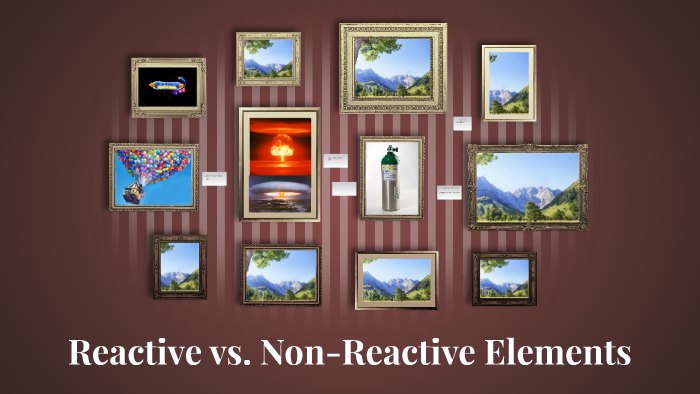

NON REACTIVITY SERIES
It’s a series of trials and tribulations that bring us closer to our eventual goal of having more control over he way we handle the stresses of life.īut in order to do this, we must first discover our triggers. A sequence that we usually follow on the road to becoming less reactive. Then finally be at a point where these situations stir up no emotional reaction at all. Then maybe have the ability to see the reaction rise and say no to it. Over time you can learn to react to 1 out of 5. At first you might react to every criticism (Fly) someone throws your way. Let’s say for example that you’re someone who is volatile and gets angry easily. The reactions that harm the people around us. In order to understand your triggers, in order to understand the flies of life, we must take inventory of the reactions of ours that have a negative ripple. The things that are most likely to get a rise out of us.Įveryone has unique triggers that get them stressed/angry/anxious/frustrated….you name it. In the analogies above, the “Fly” is any emotional trigger in life. I believe that these levels are a reflection of how most of us react to situations in life. The master who is able to have the problems of life land squarely on his/her face and not react to them, but remain focused on their true goals. *This is the true master of healthy indifference. You were merely a series of landing pads for the fly. The fly came and went without receiving a reaction. You notice the fly momentarily, but it doesn’t disrupt your focus. This time, it lands on your arm and starts walking around. Although temporarily taken out of the present moment, they have the ability to return back. The person who is able to notice when a distraction or interruption has taken place, be aware of it, but still remain immersed in the task at hand. *This is the person who makes a mistake, but is able to catch themselves. The fly got a reaction out of you, but you returned back quickly. You also didn’t try to shake the fly off of you. The fly temporarily disrupted your attention, but eventually you went back to reading. You take a look at it, and then return back to reading. This time, it lands on your arm and starts walking around.Īt first, you notice it and pick your head up from your book. One of fear that will stop you dead in your tracks. The simple act of saying “don’t react don’t react” is a reaction in itself. *This is the non-reactive robot. While you were “non-reactive” you were frozen in fear. The fly got a reaction out of you in your attempt to not react. Instead of reading your book, you’re focused on the fly and waiting for it to leave. Not quite reacting by swatting at it, but no longer present either. Your mind revolts and says “don’t react, don’t react”. Then it lands on your arm and starts walking around. You hope that by ignoring it it will fly away on it’s own. This time, you don’t want to react to it. They can’t just sit still and watch the fly come and go, they have to make a fuss about it. The second a fly buzzes in their ear, they freak out about it. The person who swats at every small problem that arises. *This is the emotionally reactive person. The fly got the best of you and got you to react. Eventually you get angry and leave because you can’t take it anymore. You get frustrated with the fly that won’t leave you alone. Imagine that you’re sitting in a park reading a book when a fly circles by your head.Īt first, you try to swat at it and get it away from you…but no matter how many times you swat, it keeps circling back. Four stages best illustrated through the annoyance of a simple fly… The Four Levels of Reactivity – The Analogy of the Fly Level 1 – Emotionally Reactive I personally believe that along this path of cultivating a healthy control over your reactions, many of us will go through four common stages. This means instead of being swayed by the winds of external circumstance, you’re anchored into your own lack of emotional reactivity. To be as Steven Covey says, “Response-able” or “able to control our responses”. Instead, the goal of these practices is to be aware of and in control of your reactions. We don’t want you to stop reacting to things and allow everything to happen, that’s not the aim. The goal here is NOT to become an emotionless robot. Note that this is different than avoidance or non-reactivity.
NON REACTIVITY HOW TO
Whether you’re studying Stoicism, Buddhist Meditation, Mindfulness, or simply practicing How to Not Give a Fuck, the underlying principle remains the same – How to become less reactive and more emotionally stable. “Learn to sit with the flies, allow them to land on your arm, walk around, and then fly away.”


 0 kommentar(er)
0 kommentar(er)
